I can’t help but think that this is a place that Colm and Mom should be on holidays together, instead of me! It must be a conservation architect’s Mecca and a heavenly place to get lost in the deep and mysterious art-history.
My words, however descriptive I try to make them, with whichever collection of cliches I choose, will fall short of doing justice to the remarkable place that is Angkor! Words will fail me, so I resort to pictures and photographs. It is really hard to choose from the 100s of photos I have taken over the past four days, but I shall litter a lot of them through out this post!
Angkor in Khmer means capital. The Khmer capital was based in Angkor between the 9th and 14th centuries. During that time Buddhism replaced Hinduism as the dominant religion of the Khmer empire/Cambodia, and the distinct architectural and artistic changes are evident. In its heyday during the 12th century, Angkor was the biggest city in the world, at 1 million people (0.1% of the then world population). Such social and political organisation is amazing (and I have a full appreciation of it after listening to the “a history of the world in 100 objects” podcast on the Ur Standard: worth listening to – click here…not now but later if you are still interested!).
Mystery abounds here – especially as to why Angkor was abandoned as the capital – rendering it impossible to maintain the vast array of buildings, palaces and temples.
The scale of the buildings are truly expansive, but more so the size of the entire Angkor area, covering some 1,000 square km. The capital temporarily relocated to outlying areas such as Koh Ker for short periods (ranging between 50km to 150km north east of Angkor), where there are other sites that we didn’nt get to visit. I could spend WAY longer here, and would do it again without kids, whose attention span is less than mine. They claim to be “templed-out” right now, and did protest too much.
The logistics, physical effort and manipulation of elephants and slaves to haul the stones is truly staggering. Many stones have round holes in them, tell-tale signs of how they were transported. Sandstone (cut into blocks) was brought from a quarry 50km from the site – slaves hoisted the stone to the riverside, elephants loaded the stones onto barges, which were carried down the Siem Reap river to Angkor, where slaves lugged the stones and boulders into place. I am not sure whether the carvings were done in-situ at each temple, but I suspect they were. The design and vision in the planning process could be considered crazy! Initially they created artificial landscapes from the jungle, through forest clearance, 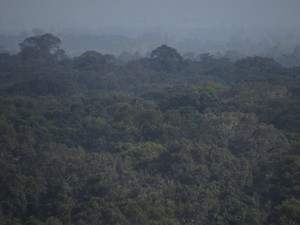
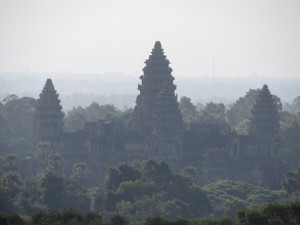 then constructing ‘barays’ (some HUGE) wherein water was diverted and elaborate irrigation reservoirs were constructed to support the burgeoning Angkor population. A baray is an artificial reservoir which has not been excavated, but in which the water is contained by dykes. One such baray remains, and water has been maintained in it for over 900 years.
then constructing ‘barays’ (some HUGE) wherein water was diverted and elaborate irrigation reservoirs were constructed to support the burgeoning Angkor population. A baray is an artificial reservoir which has not been excavated, but in which the water is contained by dykes. One such baray remains, and water has been maintained in it for over 900 years.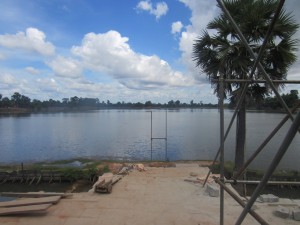
Others have dried up, leaving vast rectangle plains, now used for agriculture.
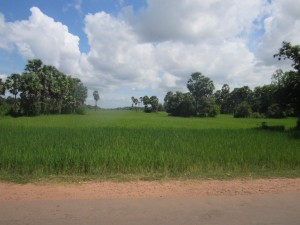
The most recent theory as to the switching of the capital from Angkor to Phnom Penh is that the irrigation system was damaged (perhaps by invading Chams, perhaps through local change in climatic conditions……no definitive answer)….experts aren’t sure. Angkor was described as a “hydraulic city” because of its complicated water management network, which was used for stabilising, storing and dispersing water throughout the area. One of the temples I visited was out on its own, with little physical walls or defences. This was because it was built in the middle of the biggest baray, and would have been surrounded by water.
Of the over 1,000 temples of the ancient city(ies), many were abandoned and fell to wrack and ruin, under the recolonisation of the jungle. Others such as Angkor Wat have been in continuous use over time, albeit through changing religions and worship through the kalpa (cycle of time in Hindhu).
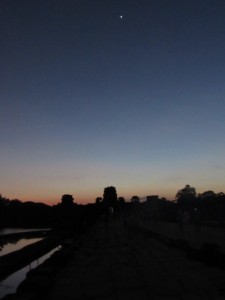 I had a spine tingling experience on first casting my eyes on the silhouette of Angkor Wat, in the muted darkness of pre-dawn. Breathtaking grandeur shrouded with wonder left me with a humbling admiration for this ancient civilisation. Raffles, who founded Singapore, also spent time in Java (one of the first Westerners to discover Borobudur temple) and believed fervently in the concept of civilisation. He never defined it, but his clear markers were: the possession of a writing system, the second is social hierarchy and yet another was the possession of complex stone architecture in his view.
I had a spine tingling experience on first casting my eyes on the silhouette of Angkor Wat, in the muted darkness of pre-dawn. Breathtaking grandeur shrouded with wonder left me with a humbling admiration for this ancient civilisation. Raffles, who founded Singapore, also spent time in Java (one of the first Westerners to discover Borobudur temple) and believed fervently in the concept of civilisation. He never defined it, but his clear markers were: the possession of a writing system, the second is social hierarchy and yet another was the possession of complex stone architecture in his view.
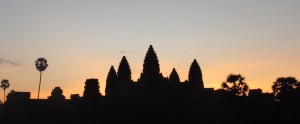 Eastern civilisations seem all the more rich and ingenious than our presumed golden epoch of Western Modernity. I personally think that Eastern civilisation will rise and dominate globally – perhaps South-East Asia coat-tailing on the rise of China and India…..in a Phoenix like resurrection following the most recent two centuries of turbulence. The interesting political question, for me, is to what extent the tentacles of Russian investment will influence this rising, curbing its flight.
Eastern civilisations seem all the more rich and ingenious than our presumed golden epoch of Western Modernity. I personally think that Eastern civilisation will rise and dominate globally – perhaps South-East Asia coat-tailing on the rise of China and India…..in a Phoenix like resurrection following the most recent two centuries of turbulence. The interesting political question, for me, is to what extent the tentacles of Russian investment will influence this rising, curbing its flight.
Visiting Angkor requires making dizzying choices regarding which sites to visit, out of the myriad of literally 100s of options in the total Angkor area. Temples are predominantly made from sandstone. The right to dwell in stone buildings was reserved for the Gods only. All the wooden structures that would have constituted the distinct cities and city areas within Angkor have long since decayed, been rebuilt and disintegrated again and again. Skeletal ruins of once magnificently adorned edifices that were enamelled with gold, bronze and other embellishments are all that remain, although there are villages scattered throughout the entire Angkor area.
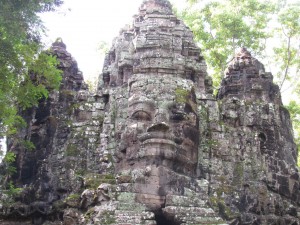
The Bayon (within Angkor Thom)
It’s difficult to pick highlights or to describe the sheer complexity, ingenuity, scale, beauty and quirkiness in each structure that we saw……but for me, I returned for a second visit to the Bayon (within Angkor Thom, which was the last and most enduring city of the Khmer empire) – famous for its monumental carved faces – over 216 in total, facing in every-which direction. The Gods are omnipresently watching over everything. The Bayon was built over extended timeframes, with successive architects whimsically leaving their mark, adding buildings within buildings……resulting in a haphazard complex maze of corridors, nooks and crannies.
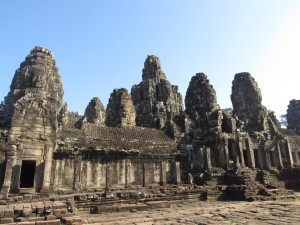
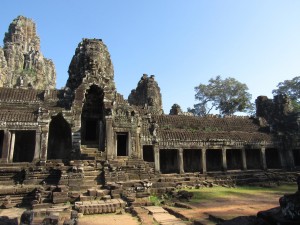
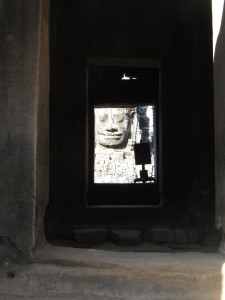
On the first day at the Bayon we lost Ilona and Tadhg, as they were having an intrepid climbing adventure, in one corner of the Bayon! I was relieved to find them, despite other times wishing we could lose them! (Joke!)
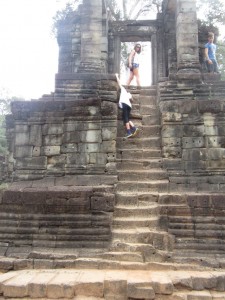
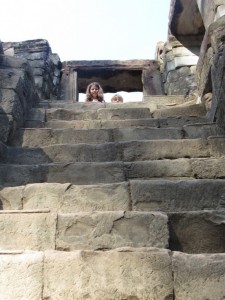
I particularly like the Bas Relief (carvings) in the sandstone at Bayon, which differed to those at Angkor Wat. A way to teach history through art…..passing down stories through an amazing enduring visual medium. The language of Art.
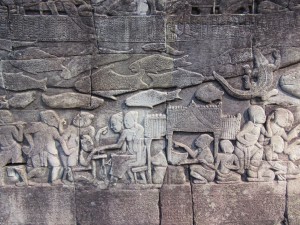
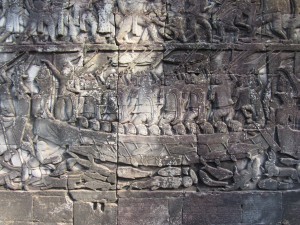
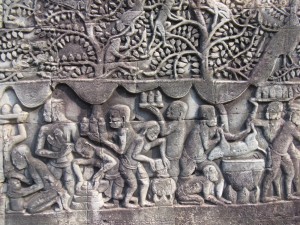
Some more pictures (can’t help myself, as I think this place is awesome!).
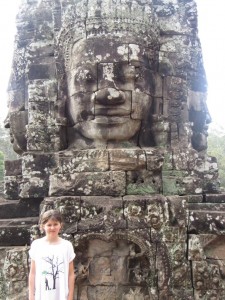
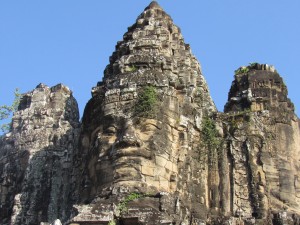
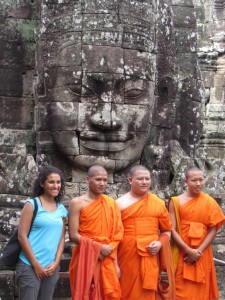
Parts of the structure have been restored, but there are piles upon piles of stones yet to be sorted, catalogued and organised for this giant 3-d jigsaw puzzle.
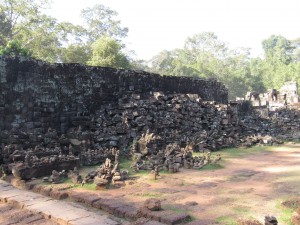
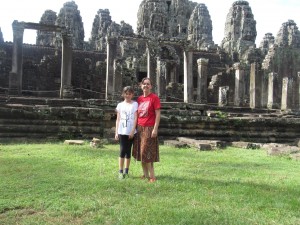
The Bayon is part of Angkor Thom, and the gates to Angkor Thom were pretty spectacular. Again a moat runs around the old Angkor Thom city, and each gate have depictions of the Gods holding the serpent, a theme that runs throughout a lot of the temples although built in different times. Our first gate was the Southern one, and some of the restoration involved the use of different materials than the original (many of which were destroyed over the centuries – apparently surprising was that there was little destruction of these sites during the shambolic Khmer Rouge regime).
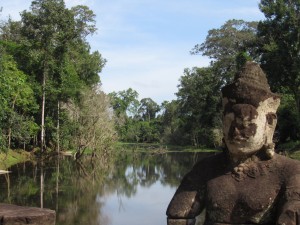
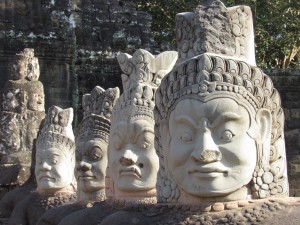
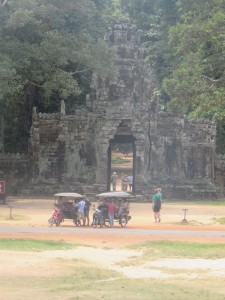
The shafts of light at the north gate were spectacular the day we went there.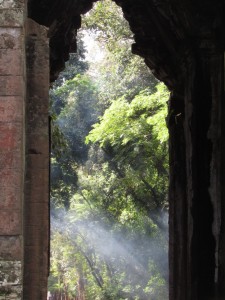
Also within Angkor Thom is the Baphuon, which is a large temple mountain. Under 12s were not allowed in, so I sat this one out with Ilona and Tadhg, as Daniel scaled the steep internal, and managed to take this shot of us (I think Tadhg and Ilona were doing a pre-rugby World Cup final haka!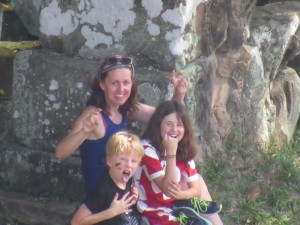
The Bauphon is pretty impressive, with an amazing walkway to it. What bemused me was that this was one of the first sites that restoration began on. 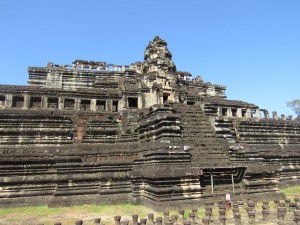
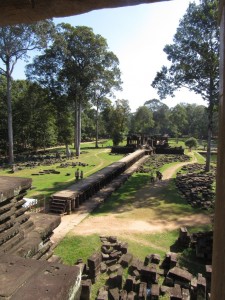
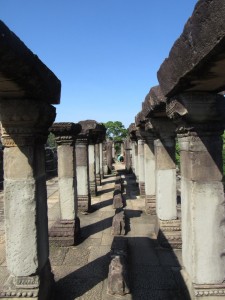
Out in front (where we were sitting) there were rows upon rows of stones in neat lines. The project began in the early 1970s, with archaeologists dismantling much of it. However, the restoration project was abandoned in 1975 due to the war. Alas, the plans were lost, so it is a nightmare now to try to piece back all these large stones.
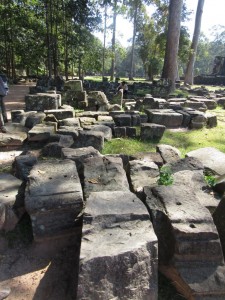
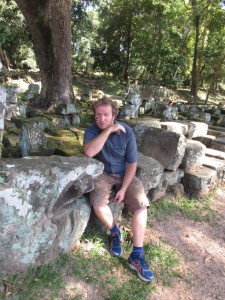
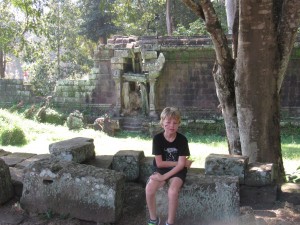
The tallest scalable structure is Phimeanakas, still within Angkor Thom. Very pretty…..nearly as pretty as the photo of Ilona with it as a backdrop!
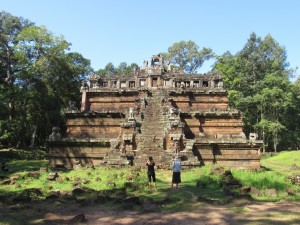
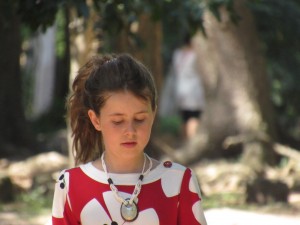
We also walked on and saw the Terrace of Elephants, Harry Potter look-alike towers (mainly because they were wonky) – Prasat Suor Pat – which were 12 nearly identical towers, and the kids rambled through and explored umpteen Windows, frames, corridors, gateways etc. exhausting but most fabulous days.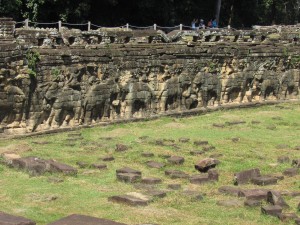
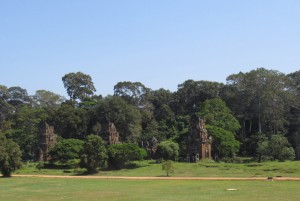
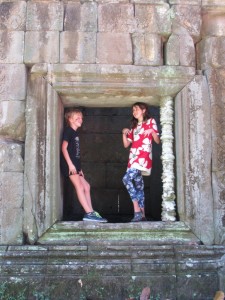
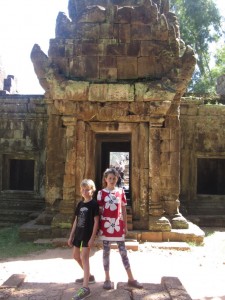
Preah Khan
I also loved Preah Khan, once a university with an accompanying surrounding town/city all to itself. The proximity of each temple to eachother masks the fact that each temple had a hey-day, and not all of the temples would have been used at the same time. The chronology of the temples was beyond me……but another thing I would like to learn more about. 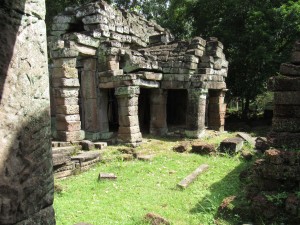
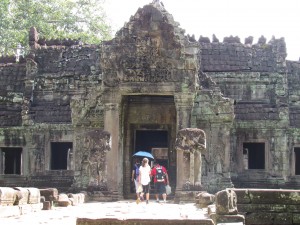
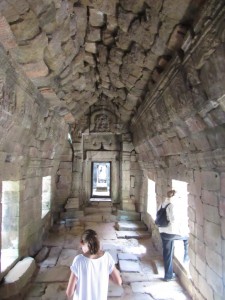
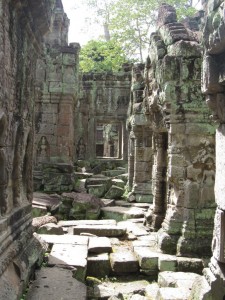 Preah Khan is a fusion of Hinduism and Buddhism. It combines buildings and carvings of both religions.
Preah Khan is a fusion of Hinduism and Buddhism. It combines buildings and carvings of both religions.
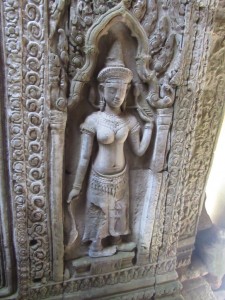
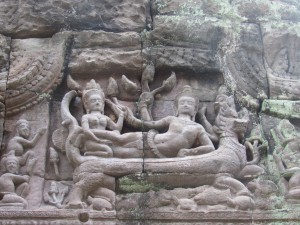 I lingered here longer than any other temple, for two reasons: 1. I met a really interesting older English lady and we sat on the ancient stones and conversed for ages. 2. Subsequently I realised I lost my wallet in Preah Khan, so retraced my steps through the fallen down blocks and boulders, rubble and ruin of stones, in a vain attempt to locate it. St. Anthony was even called upon, despite there being no room for Christianity here (I was thinking that I should be evoking St. Jude, as the chances of finding it was as great as finding a needle in a haystack!). Alas, I left Preah Khan walletless, and a heavy heart at having to cancel bank cards, the loss of some dear photos I kept there and my NZ SIM card.
I lingered here longer than any other temple, for two reasons: 1. I met a really interesting older English lady and we sat on the ancient stones and conversed for ages. 2. Subsequently I realised I lost my wallet in Preah Khan, so retraced my steps through the fallen down blocks and boulders, rubble and ruin of stones, in a vain attempt to locate it. St. Anthony was even called upon, despite there being no room for Christianity here (I was thinking that I should be evoking St. Jude, as the chances of finding it was as great as finding a needle in a haystack!). Alas, I left Preah Khan walletless, and a heavy heart at having to cancel bank cards, the loss of some dear photos I kept there and my NZ SIM card. 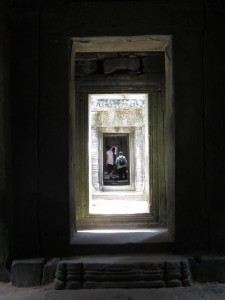 Ilona and I continued through some temples hungry and lunchless, but I was adamant to see as much as we could while we had the chance! Luckily for me, my new English acquaintance had accidentally taken my wallet somehow, while we were exchanging information and stories! She said she had the greatest adventure trying to locate me to return it, and located me in the evening! Another new friend made, as I know our paths will cross again.
Ilona and I continued through some temples hungry and lunchless, but I was adamant to see as much as we could while we had the chance! Luckily for me, my new English acquaintance had accidentally taken my wallet somehow, while we were exchanging information and stories! She said she had the greatest adventure trying to locate me to return it, and located me in the evening! Another new friend made, as I know our paths will cross again.
Another iconic temple is Ta Prohm, now more famous for the location of Lara Croft, Tombraider (I confess I have not seen the film). The temple is spectacular. I could go into the history (one of the kings built this for his mother, before dedicating the neighbouring Preah Khan to his father…….but those details only come alive when you are in a place, me thinks…..so I will let the pictures do the talking!). This is one of the temples where the jungle has taken over, resolutely claiming its patch back over the transient buildings, however spectacular.
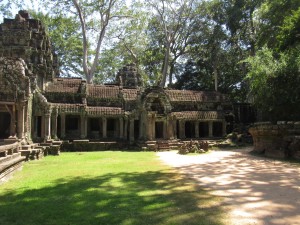
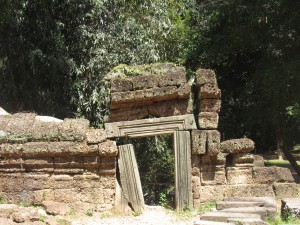
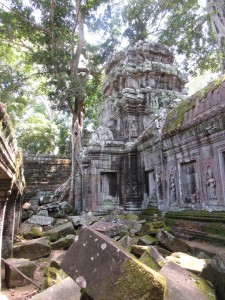
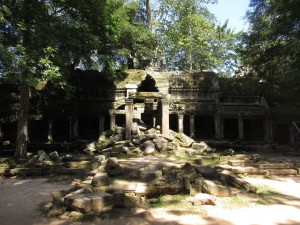
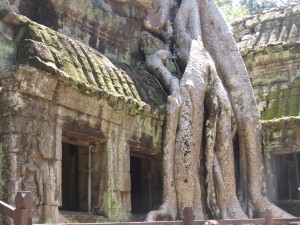
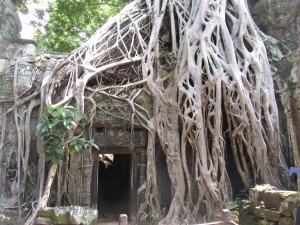
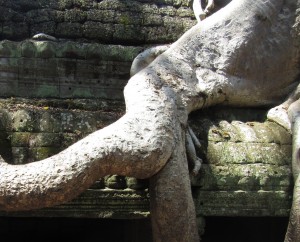
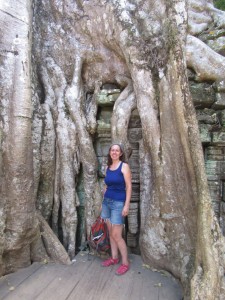
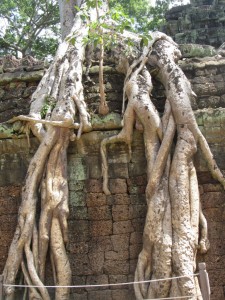
There is a restoration process going on, with one part completely reconstructed (with support from the Indian government):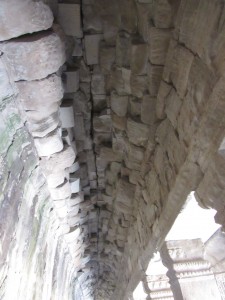
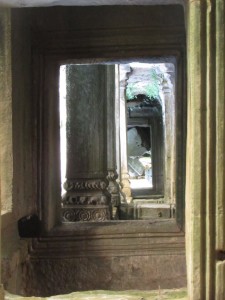 Yet in other places on the site, you are stepping over ornate lintels and embellishments that I have no names for:
Yet in other places on the site, you are stepping over ornate lintels and embellishments that I have no names for:

It is needless to mention that it is impossible not to be enthusiastic about Angkor Wat itself – Cambodia’s iconic temple, the largest religious building in the world. The moat and exterior wall is 1.3km x 1.5km. The temple itself is 1km squared. I visited it twice also – once for sunrise (along with the throngs and masses of people! See picture below of all the people watching the sunrise, from the prime position to get the reflection of the quincunx on the water),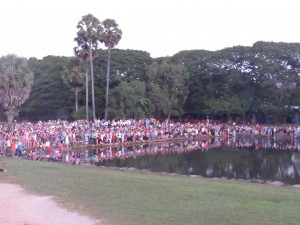
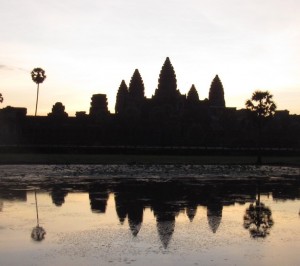 and the second visit to focus on the Bas-relief (sandstone carvings) that surround the 1st level exterior. This is the most ornate wall, and truly is an amazing feat of craftsmanship.
and the second visit to focus on the Bas-relief (sandstone carvings) that surround the 1st level exterior. This is the most ornate wall, and truly is an amazing feat of craftsmanship.
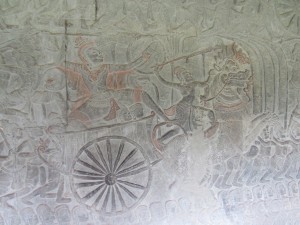
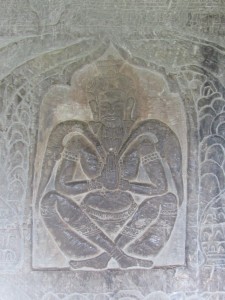
Angkor Wat is a three tiered pyramid crowned by five lotus like towers (symbolic of prosperity in Buddhism). It is 65m from ground level, constructed as a Hindhu temple, but Buddhist since it became Khmer/Cambodia’s dominant religion in the 14th century. It was thought to be a mausoleum, or Chedi as it faces west, but there is no evidence of burial. It was here that I learnt the beautifully descriptive word “quincunx” which describes an arrangement of five objects in which the four occupy the corners and the fifth the centre (like the arrangement of dots on the five side of a dice – hat-tip Colm, and his hat-tip to Auntie Lil’s ancient brown dictionary conferred to Dad….in lieu of inheriting the house, donkey or cart he (Dad) fondly also remembers!). It is also the representation in stone of a “Kalasa”, which is a pot filled with water and plants, symbolising prosperity – a kind of cornucopia.
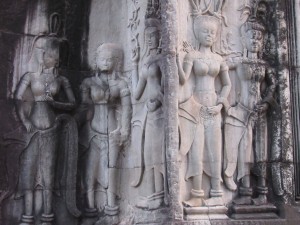
There is symbolism galore in Angkor Wat, as in the other temples. It is supposed to resemble the earth and Mt Meru (from Hindu). Making a pilgrimage to the top requires huge physical effort, with steep steps in the inner towers of the third enclosure, as you ascend out of the earth and into heaven.
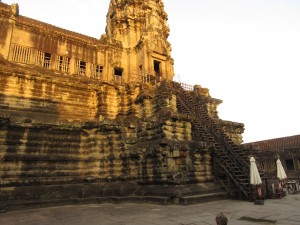
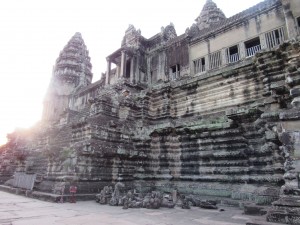
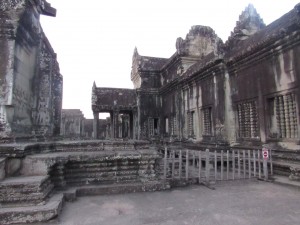
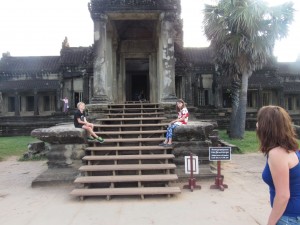
Even the most is a feat of engineering; its serene and beautiful!
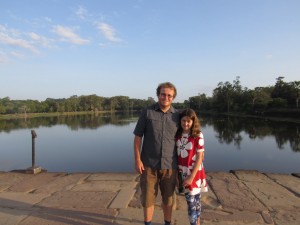
In “A history of the world in 100 objects”, McGregor describes the universal paradox of religious homage through monumental buildings: you need huge material wealth, acquired only through intense engagement with the rest of the world, to build monuments that inspire us to abandon wealth and to leave the world behind! I fear that in the West we are acquiring that wealth, but in no way abandoning materiality for any religious or environmental (which is akin to religion in my estimation) cause. It’s a baseless selfish democratised accumulation of wealth!
Interesting podcasts of relevance I have listened to:
The Borobudur Buddha of Java , of course in relation to another site, states that humans…..
http://www.bbc.co.uk/ahistoryoftheworld/objects/CPbWMMoFSnmUlSHF3dkf5A
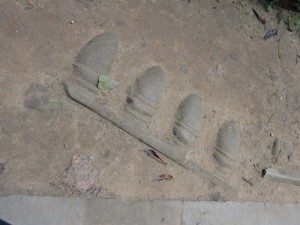
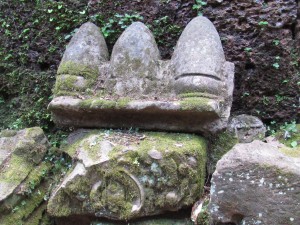
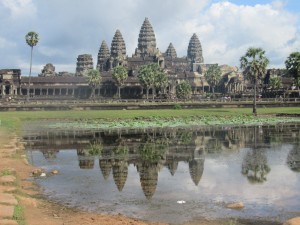
Leave a Reply